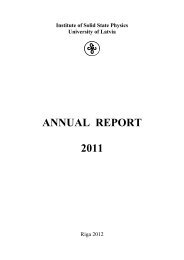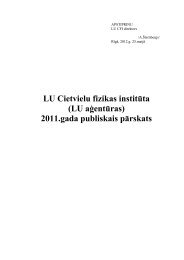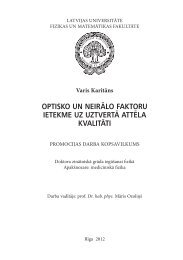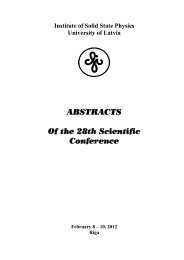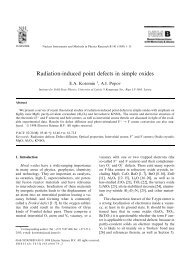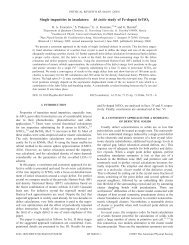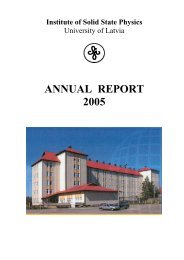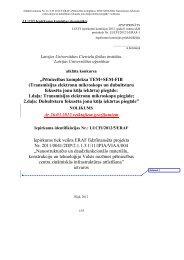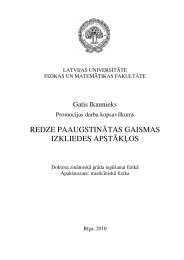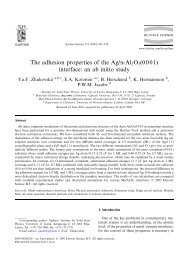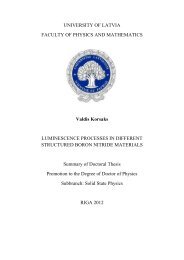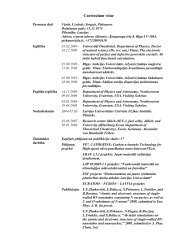Annual Report 2012 - Latvijas Universitātes Cietvielu fizikas institūts
Annual Report 2012 - Latvijas Universitātes Cietvielu fizikas institūts
Annual Report 2012 - Latvijas Universitātes Cietvielu fizikas institūts
Create successful ePaper yourself
Turn your PDF publications into a flip-book with our unique Google optimized e-Paper software.
STATISTICAL ANALYSIS AND CELLULAR AUTOMATA MODELING OF<br />
VOID LATTICE FORMATION IN ELECTRON IRRADIATED CaF 2<br />
P Merzlyakov, G Zvejnieks, V N Kuzovkov and E A Kotomin<br />
Calcium fluoride (CaF 2 ) is widely used in both microlithography and as a deep UV<br />
window material. It is also known that electron beam irradiation creates a superlattice<br />
consisting of periodically distributed fluorine vacancy clusters (called a void lattice).<br />
To perform a quantitative analysis of experimental TEM image data demonstrating void<br />
lattice formation under electron irradiation of CaF 2 , we developed two distinct image<br />
filters. As a result, we can easily calculate vacancy concentration, cluster distribution<br />
function as well as average distance between clusters. In particular, an analysis of the<br />
consecutive experimental snapshots obtained by increasing irradiation dose, allows us to<br />
restore the void lattice formation process. The results for two suggested filters are<br />
similar and demonstrate that void cluster growth is accompanied with a slight increase of<br />
the superlattice parameter.<br />
Despite numerous experiments, the void superlatticelattice formation in CaF 2 under<br />
electron irradiation still possesses open questions regarding the microscopic processes<br />
that govern the self-organization phenomenon. We propose a microscopic model that<br />
allows us to reproduce a macroscopic ordering in a form of void lattice, in agreement<br />
with experimental data and provide an explanation for existing theoretical and<br />
experimental contradictions. We consider fluorine sublattice, where irradiation produces<br />
correlated Frenkel defects – pairs of the F and H centers. Slow F center diffusion is<br />
accompanied with their nearest neighboring attractive interaction leading to the<br />
formation of F center clusters, i.e., voids. The driving forces for the long-range void<br />
ordering are H center planes. They are formed by highly mobile H centers due to threeatoms-in-a-line<br />
(trio) attractive interactions, see Fig. 17.<br />
Fig. 17. 3D CA simulation snapshots at the following dimensionless F center 3D<br />
concentrations and CA simulation times (a) (0.02, 0.025 s), (b) (0.04, 0.057 s), (c)<br />
(0.10, 0.207 s), (d) (0.17, 0.542 s). The F centers are marked red, the H centers - light<br />
green.<br />
Our cellular automata simulations demonstrate that global void lattice self-organization<br />
can occur only in a narrow parameter range where an average spacing between void<br />
clusters and H center planes is balanced. Moreover, we monitor also the kinetics of a<br />
void lattice ordering starting from an initial disordered stage, in agreement with the<br />
TEM experimental data.<br />
C. Plasma Physics<br />
71



